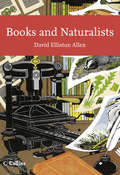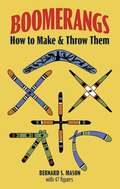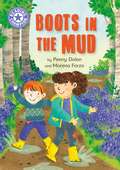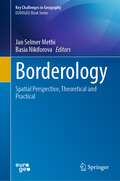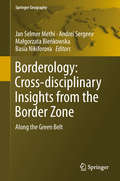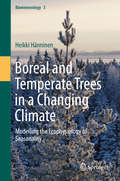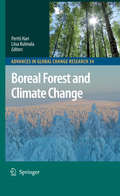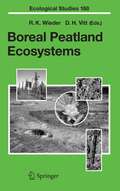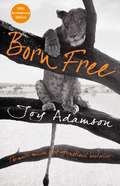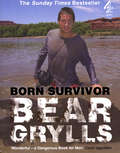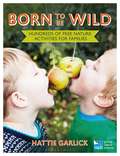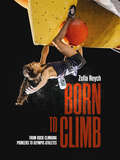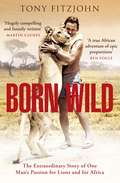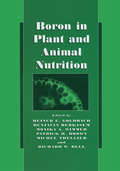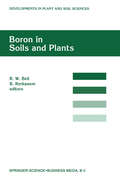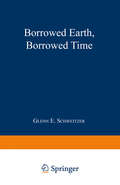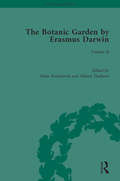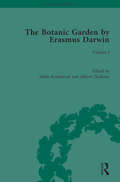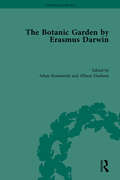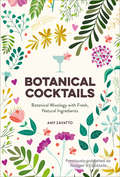- Table View
- List View
Books and Naturalists (Collins New Naturalist Library #112)
by David Elliston AllenNatural history, perhaps more than any other pursuit or study, has always relied heavily on books. Without their basic function of enabling the different kinds of animals and plants to be described in adequate detail, the subject could never have come into being and gone on to thrive as it does today.
Boomerangs: How to Make and Throw Them
by Bernard S. MasonIt only takes minutes to make a good, guaranteed-to-return boomerang. By following a few more simple steps you will learn how to throw it so it will always return to you. Soon you will be in possession of a new hobby, experimenting with many types of boomerangs, flying them in new tricks and stunts, achieving a degree of accuracy and excitement that will give you pleasure whether you are young or old, whether it is your first boomerang or your fiftieth.This is the outstanding book on boomerangs. While a certain amount of the information is drawn from native methods, most is composed of new designs by Bernard Mason that are easy to make, easy to throw, safe, and full of possibilities. There are the standards — cross-stick boomerangs ranging in size from fourteen inches to three feet. There are pin-wheel boomerangs, undoubtedly the best flyers. There are boomabirds, boomerangs in bird shapes, airplane shapes, and other ornamentals with a wealth of strange flight patterns. There are tumblesticks, boomerangs that look like nothing but simple straight sticks — until you throw them. There are boomerangs you can make from cardboard. And there are the curved stick boomerangs from Australia. In each section there are examples of the best flyers, plus others — largest, smallest, jumpers, fast flyers, smooth flyers, and many more.Since, as the author says, each boomerang possesses its own unique character, there is always the feeling of magic each time a new one is made and thrown. With this book you can learn to make nearly every type of known boomerang, learn to fly them, and add a new area of skill and recreation to your life.
Boots in the Mud: Independent Reading Purple 8 (Reading Champion #489)
by Penny DolanThis story is part of Reading Champion, a series carefully linked to book bands to encourage independent reading skills, developed with Dr Sue Bodman and Glen Franklin of UCL Institute of Education (IOE)Boots in the Mud is about the muddiest muddle imaginable! When Mia and Harry go for a walk in the forest with their mum and cousins, the mud gets the best of them as they try to cross a stream. Everyone has to laugh when they figure out what's happened to their boots in the mud!Reading Champion offers independent reading books for children to practise and reinforce their developing reading skills.Fantastic, original stories are accompanied by engaging artwork and a reading activity. Each book has been carefully graded so that it can be matched to a child's reading ability, encouraging reading for pleasure.
Borderology: Spatial Perspective, Theoretical and Practical (Key Challenges in Geography)
by Jan Selmer Methi Basia NikiforovaThis book develops and establishes knowledge about borderology in the border zone between different countries, cultures, and climatic environment. The content of border and border zone has, during our research, changed from being a physical border between states to different borders and border zones which also include social and mental borders. The COVID-19 pandemic has challenged the concept even more. The expressions “lockdown” and "social distance" indicate such borders that we, a short time ago, had largely not considered in our everyday life. Not only states closed their borders, regions inside a country, and even borders within families were established. “Illegally” passing these borders could crate strong reactions both from the nature by a disease or by the authorities with fees. The pandemic has not only challenged our understanding of borders and border zones, but it has also challenged our understanding of human rights and especially our understanding of what freedom is.
Borderology: Along the Green Belt (Springer Geography)
by Jan Selmer Methi Andrei Sergeev Małgorzata Bieńkowska Basia NikiforovaThis book provides a unique and multifaceted view on and understanding of borders and their manifestations: physical and mental, cultural and geographical, and as a question of life and death. It highlights the Green Belt along the Iron Curtain, which offered a haven for rare species for many decades and, after the Cold War, became a veritable treasure trove for a European network of researchers. A geographical border is something that can be seen, but other borders sometimes have to be crossed to be discovered. The border zone is an arena for development that is not found in any other places. This book focuses on borderology, which became the name of a cross-border study and research program that explores the border zone from multiple perspectives. This cross-disciplinary book will appeal to interested researchers and students from many fields, from philosophy and diplomacy to ecology and geography.
Boreal and Temperate Trees in a Changing Climate: Modelling the Ecophysiology of Seasonality (Biometeorology)
by Heikki HänninenThis book provides an overview of how boreal and temperate tree species have adapted their annual development cycle to the seasonally varying climatic conditions. Therefore, the frost hardy dormant phase, and the susceptible growth phase, are synchronized with the seasonality of the climate. The volume discusses the annual cycle, including various attributes such as timing of bud burst and other phenological events, seasonality of photosynthetic capacity or the frost hardiness of the trees. During the last few decades dynamic ecophysiological models have been used increasingly in studies of the annual cycle, particularly when projecting the ecological effects of climate change. The main emphasis of this volume is on combining modelling with experimental studies, and on the importance of the biological realism of the models.
Boreal Forest and Climate Change (Advances in Global Change Research #34)
by Pertti Hari Liisa KulmalaThe Forest Primary Production Research Group was born in the Department of S- viculture, University of Helsinki in the early 1970s. Intensive ?eld measurements of photosynthesis and growth of forest vegetation and use of dynamic models in the interpretation of the results were characteristic of the research in the group. Electric instrumentation was based on analogue techniques and the analysis of the obtained measurements was based on self-written programs. Joint research projects with the Research Group of Environmental Physics at the Department of Physics, lead by Taisto Raunemaa (1939–2006) started in the late 1970s. The two research groups shared the same quantitative methodology, which made the co-operation fruitful. Since 1980 until the collapse of the Soviet Union the Academy of Finland and the Soviet Academy of Sciences had a co-operation program which included our team. The research groups in Tartu, Estonia, lead by Juhan Ross (1925–2002) and in Petrozawodsk, lead by Leo Kaipiainen (1932–2004) were involved on the Soviet side. We had annual ?eld measuring campaigns in Finland and in Soviet Union and research seminars. The main emphasis was on developing forest growth models. The research of Chernobyl fallout started a new era in the co-operation between forest ecologists and physicists in Helsinki. The importance of material ?uxes was realized and introduced explicitly in the theoretical thinking and measurements.
Boreal Peatland Ecosystems (Ecological Studies #188)
by R. K. Wieder D. H. VittThis is the first truly ecosystem-oriented book on peatlands. It adopts an ecosystems approach to understanding the world's boreal peatlands. The focus is on biogeochemical patterns and processes, production, decomposition, and peat accumulation, and it provides additional information on animal and fungal diversity. A recurring theme is the legacy of boreal peatlands as impressive accumulators of carbon as peat over millennia.
Born Free: The Story of Elsa (Pan 70th Anniversary #81)
by Joy AdamsonFifty years ago Joy Adamson first introduced to the world the story of her life alongside Elsa the lioness, whom she had rescued as an orphaned cub, and raised at her home in Kenya. But as Elsa had been born free, Joy made the heartbreaking decision that she must be returned to the wild when she was old enough to fend for herself. Since the first publication of Born Free and its sequels Living Free and Forever Free, generations of readers have been enchanted, inspired and moved by these books’ uplifting charm and the remarkable interaction between Joy and Elsa. Millions have also come to know and love Born Free through the immortal film starring Virginia McKenna and Bill Travers. But here is the chance to rediscover the original story in this 50th anniversary edition, in the words of the woman who reared Elsa and walked with the lions.
Born Survivor: Bear Grylls
by Bear GryllsBear Grylls is no stranger to extremes. During a three-year stint in the SAS he was involved in a horrific parachuting accident in Africa and broke his back in three places. Months of rehabilitation followed but, never losing sight of his childhood dream of climbing Everest, Bear went on to become the youngest Briton ever to reach the summit and survive. It was a close-run thing, however, as during the descent he was almost killed in a crevasse, his life saved only by his team-mate and a rope. In 2003 Bear completed another world-record-breaking expedition, leading his team through freezing spray and icebergs across the North Atlantic Ocean in a small inflatable boat. More drama followed as Bear, a karate black belt, set out to show the viewers of Channel 4 what it is really like to complete the gruelling basic training of the Foreign Legion.Now, in Born Survivor which accompanies a brand new eight-part series for Channel 4, the world's ultimate survivor shows us how to stay alive in the most unforgiving conditions on Earth. From crossing piranha-infested rivers and finding fresh food to building bush fires and fighting off grizzly bears - all manner of survival techniques from our most dangerous environments are covered. So, whether you find yourself stranded on a desert island in the Pacific, lost in the Lake District, or stuck in the snow on Greenland, once you've read this book, you too will be able to beat the elements and survive the wild.
Born to Be Wild: Hundreds of free nature activities for families (RSPB)
by Hattie Garlick Nancy HoneyWant to save cash, your child's imagination and possibly even the planet? This is the book you need.Packed with great photos of real families in the outdoors, Born to Be Wild contains easy-to-follow instructions for activities that require nothing more sophisticated than a small person's imagination and access to a little outdoor space.Nature lays on magical materials for free each season, from fallen leaves and twigs, moulted feathers, sand and shells, to mud, puddles and rain. Everything else you'll need for these activities is already hiding in your cupboards at home. No expensive art supplies of outward-bound kit required. All you need are the toolkit items at the front of the book - ordinary household essentials like scraps of paper, string, glue, recycled food containers and an empty jar or two.Along the way Hattie talks to families, organisations and communities who have rebuilt their relationships with nature with extreme or inspiring results, and she introduces scientists, psychologists and other experts who explain why, as modern families, we should revive our waning relationships with nature, whatever age or stage we're at.
Born to Be Wild: Hundreds of free nature activities for families (RSPB)
by Hattie Garlick Nancy HoneyWant to save cash, your child's imagination and possibly even the planet? This is the book you need.Packed with great photos of real families in the outdoors, Born to Be Wild contains easy-to-follow instructions for activities that require nothing more sophisticated than a small person's imagination and access to a little outdoor space.Nature lays on magical materials for free each season, from fallen leaves and twigs, moulted feathers, sand and shells, to mud, puddles and rain. Everything else you'll need for these activities is already hiding in your cupboards at home. No expensive art supplies of outward-bound kit required. All you need are the toolkit items at the front of the book - ordinary household essentials like scraps of paper, string, glue, recycled food containers and an empty jar or two.Along the way Hattie talks to families, organisations and communities who have rebuilt their relationships with nature with extreme or inspiring results, and she introduces scientists, psychologists and other experts who explain why, as modern families, we should revive our waning relationships with nature, whatever age or stage we're at.
Born to Climb: From rock climbing pioneers to Olympic athletes
by Zofia ReychClimbing is one of the world’s fastest-growing sports – exciting, addictive and, arguably, much more fun than going to the gym. In 2021 it made its long-awaited Olympic debut, but its journey to Tokyo has been anything but traditional. And the traditionalists would argue that it’s not even a sport at all …In Born to Climb, anthropologist and climber Zofia Reych shares with us the fascinating cultural history of rock and competition climbing. Zofia offers a fresh perspective on some of the pivotal moments and outstanding individuals of the sport, from eighteenth-century exploratory forays on rock, via the rise of climbing legends such as Emilio Comici, Wolfgang Güllich and Lynn Hill, to the limelight of the Olympic arena for the stars of today – Janja Garnbret, Adam Ondra, Shauna Coxsey and more.But Born to Climb is much more than a celebration of the sport’s famous people and places: it is an examination of modern sporting participation and culture, interwoven with the author’s own climbing journey. While the writing is engaging and often funny, Zofia is not afraid to broach sensitive and often overlooked topics, including gender divide, capitalism and the tension between aesthetic and athletic approaches to climbing, in what is a must-read for all climbers.
Born Wild: The Extraordinary Story of One Man's Passion for Lions and for Africa.
by Tony FitzjohnBorn Wild is a story of passion, adventure and skulduggery on the frontline of African conservation. Following Tony Fitzjohn's journey from London bad boy to African wildlife warrior, the heart of the story is a series of love affairs with the world's most beautiful and endangered creatures - affairs that so often end in pain, for to succeed in re-introducing a lion or leopard to the wild is to be deprived of their companionship. Tony tells of his twenty years in Kenya with George Adamson of Born Free fame - a time of discovery, isolation and frequent danger living far from civilisation. And when he was prevented from re-introducing any more animals into the wild and made unwelcome in the country he loved, Tony had to start anew in Tanzania.
Boron in Plant and Animal Nutrition
by Benjavan Rerkasem Monika A. Wimmer Patrick H. Brown Michel Thellier R. W. Bell Heiner E. GoldbachThe Boron '97 meeting was a great success in summarising all recent developments in basic and applied research on boron's function, especially in plants. New techniques have since been developed and new insight has been gained into the role of boron in plant and animal metabolism. Nevertheless, there were still lots of open questions. The aim of the present workshop held in Bonn as a satellite meeting to the International Plant Nutrition Colloquium was thus to gather all actual information which has been gained since the Boron '97 meeting and to compile knowledge, both from animal and plant sciences. Furthermore, applied aspects had to be addressed too, as there is an increasing awareness of boron deficiencies even in crops such as wheat, which have formerly not been considered as responsive to boron application. Genetic differences in boron demand and efficiency within one species are a further important topic which has gained importance since the 1997 meeting. More in-depth knowledge on the mechanisms of boron efficiency are required as an increased efficiency will be one major possibility to maintain and improve crop yields for resource-poor farmers. Nevertheless, it has also clearly been shown that an adequate supply of boron is needed to obtain high yields of crops with a high quality, and that a sustainable agriculture has to provide an adequate boron supply to compensate for inevitable losses through leaching (especially in the humid tropics and temperate regions) and for the boron removal by the crop.
Boron in Soils and Plants: Proceedings of the International Symposium on Boron in Soils and Plants held at Chiang Mai, Thailand, 7–11 September, 1997 (Developments in Plant and Soil Sciences #76)
by R. W. Bell Benjavan RerkasemThe economic significance of boron (B) in agriculture, horticulture, and forestry has been beyond dispute for several decades. Even in the last two decades, the areas where B deficiency limits plant production has grown with increased reports from China, south Asia and southeast Asia. The present volume is reflective of the growing awareness of the significance of low soil B with reports from Australia, Bangladesh, Brazil, north, central and southern China, India, Nepal, and the North West Frontier Province of Pakistan contained herein. Boron deficiency also continues to be a problem for crop yield and quality in areas where B deficiency has been known for some time, for example in Germany and the USA. The problem of low soil B is not limited to effects on field crop yield, with papers reporting on depressed wood yield and quality in timber trees (Lambert et al. ), and depressed fruit quality (Dong et al. ; Smith et al. : Zude et al. ) also appearing in the present volume. Globally, Shorrocks (1997)1 estimates that ?? tonnes of B fertiliser is applied annually in agriculture. The economic benefits from the use of B fertiliser have not been quantified but are clearly enormous. Paradoxically, the clear economic imperatives for using B fertiliser on low B soils are not matched by a similar clarity of understanding of the role and functions of B in plants.
The Botanic Garden by Erasmus Darwin: Volume II (The Pickering Masters)
by Adam KomisarukThe career of Erasmus Darwin (1731-1802) affords an extraordinary glimpse into the intellectual ferment of late-eighteenth- and early-nineteenth-century Britain. As a popular poet, practicing physician, inventor of speaking machines and mechanical birds, essayer of natural history from geology to meteorology, and proponent of an evolutionary theory that inspired his famous grandson Charles, he left a lasting impression on almost every branch of knowledge. His magnum opus, and the synthesis of his myriad interests, is The Botanic Garden (1792) — an epic poem that aims to "enlist the Imagination under the banner of Science." Part I, The Economy of Vegetation, sings the praises of British industry as a dance of supernatural creatures while part II, The Loves of the Plants, wittily employs metaphors of human courtship to describe the reproductive cycles of hundreds of flowers. Darwin supplements his accomplished verses with (often much longer) "philosophical notes" that offer his idiosyncratic perspective on the scholarly controversies of the day. Despite a recent surge of academic interest in Darwin, however, no authoritative critical edition of The Botanic Garden exists, presenting a barrier to further scholarship. This two volume set comprises a complete, meticulously transcribed, reading text — including all the poetry, prose apparatus, and illustrations — along with extensive commentary that situates Darwin within contemporary debates about the natural sciences. This set will be of interest to readers as the definitive reference edition of The Botanic Garden and due to its efforts to make the work more practically and intellectually accessible to seasoned and novice readers alike This second volume includes the full version of the second part of The Botanic Garden, The Lives of Plants along with the related textual apparatus consisting of the editors’ annotations, discussion of the illustrations, textual notes, and a taxonomic table of the flowers mentioned.
The Botanic Garden by Erasmus Darwin: Volume I (The Pickering Masters)
by Adam KomisarukThe career of Erasmus Darwin (1731-1802) affords an extraordinary glimpse into the intellectual ferment of late-eighteenth- and early-nineteenth-century Britain. As a popular poet, practicing physician, inventor of speaking machines and mechanical birds, essayer of natural history from geology to meteorology, and proponent of an evolutionary theory that inspired his famous grandson Charles, he left a lasting impression on almost every branch of knowledge. His magnum opus, and the synthesis of his myriad interests, is The Botanic Garden (1792) — an epic poem that aims to "enlist the Imagination under the banner of Science." Part I, The Economy of Vegetation, sings the praises of British industry as a dance of supernatural creatures while part II, The Loves of the Plants, wittily employs metaphors of human courtship to describe the reproductive cycles of hundreds of flowers. Darwin supplements his accomplished verses with (often much longer) "philosophical notes" that offer his idiosyncratic perspective on the scholarly controversies of the day. Despite a recent surge of academic interest in Darwin, however, no authoritative critical edition of The Botanic Garden exists, presenting a barrier to further scholarship. This two volume set comprises a complete, meticulously transcribed, reading text — including all the poetry, prose apparatus, and illustrations — along with extensive commentary that situates Darwin within contemporary debates about the natural sciences. This set will be of interest to readers as the definitive reference edition of The Botanic Garden and due to its efforts to make the work more practically and intellectually accessible to seasoned and novice readers alike. The first volume presents a wide ranging and authoritative introduction to The Botanic Garden, detailing the background to the work and the various contexts in which it should be understood. These include: aesthetic theory and practice, the science of the mind, love and sexuality, politics, spirituality, the natural sciences, and evolutionary theory and the two Darwins. The full text of Part I of the The Botanic Garden, The Economy of Vegetation, then follows accompanied by the editors’ annotations, discussion of illustrations and textual notes.
The Botanic Garden by Erasmus Darwin: Volume I (The Pickering Masters)
by Adam KomisarukThe career of Erasmus Darwin (1731-1802) affords an extraordinary glimpse into the intellectual ferment of late-eighteenth- and early-nineteenth-century Britain. As a popular poet, practicing physician, inventor of speaking machines and mechanical birds, essayer of natural history from geology to meteorology, and proponent of an evolutionary theory that inspired his famous grandson Charles, he left a lasting impression on almost every branch of knowledge. His magnum opus, and the synthesis of his myriad interests, is The Botanic Garden (1792) — an epic poem that aims to "enlist the Imagination under the banner of Science." Part I, The Economy of Vegetation, sings the praises of British industry as a dance of supernatural creatures while part II, The Loves of the Plants, wittily employs metaphors of human courtship to describe the reproductive cycles of hundreds of flowers. Darwin supplements his accomplished verses with (often much longer) "philosophical notes" that offer his idiosyncratic perspective on the scholarly controversies of the day. Despite a recent surge of academic interest in Darwin, however, no authoritative critical edition of The Botanic Garden exists, presenting a barrier to further scholarship. This two volume set comprises a complete, meticulously transcribed, reading text — including all the poetry, prose apparatus, and illustrations — along with extensive commentary that situates Darwin within contemporary debates about the natural sciences. This set will be of interest to readers as the definitive reference edition of The Botanic Garden and due to its efforts to make the work more practically and intellectually accessible to seasoned and novice readers alike. The first volume presents a wide ranging and authoritative introduction to The Botanic Garden, detailing the background to the work and the various contexts in which it should be understood. These include: aesthetic theory and practice, the science of the mind, love and sexuality, politics, spirituality, the natural sciences, and evolutionary theory and the two Darwins. The full text of Part I of the The Botanic Garden, The Economy of Vegetation, then follows accompanied by the editors’ annotations, discussion of illustrations and textual notes.
The Botanic Garden by Erasmus Darwin: Volume II (The Pickering Masters)
by Adam KomisarukThe career of Erasmus Darwin (1731-1802) affords an extraordinary glimpse into the intellectual ferment of late-eighteenth- and early-nineteenth-century Britain. As a popular poet, practicing physician, inventor of speaking machines and mechanical birds, essayer of natural history from geology to meteorology, and proponent of an evolutionary theory that inspired his famous grandson Charles, he left a lasting impression on almost every branch of knowledge. His magnum opus, and the synthesis of his myriad interests, is The Botanic Garden (1792) — an epic poem that aims to "enlist the Imagination under the banner of Science." Part I, The Economy of Vegetation, sings the praises of British industry as a dance of supernatural creatures while part II, The Loves of the Plants, wittily employs metaphors of human courtship to describe the reproductive cycles of hundreds of flowers. Darwin supplements his accomplished verses with (often much longer) "philosophical notes" that offer his idiosyncratic perspective on the scholarly controversies of the day. Despite a recent surge of academic interest in Darwin, however, no authoritative critical edition of The Botanic Garden exists, presenting a barrier to further scholarship. This two volume set comprises a complete, meticulously transcribed, reading text — including all the poetry, prose apparatus, and illustrations — along with extensive commentary that situates Darwin within contemporary debates about the natural sciences. This set will be of interest to readers as the definitive reference edition of The Botanic Garden and due to its efforts to make the work more practically and intellectually accessible to seasoned and novice readers alike This second volume includes the full version of the second part of The Botanic Garden, The Lives of Plants along with the related textual apparatus consisting of the editors’ annotations, discussion of the illustrations, textual notes, and a taxonomic table of the flowers mentioned.
The Botanic Garden by Erasmus Darwin (The Pickering Masters)
by Adam Komisaruk Allison DushaneThe career of Erasmus Darwin (1731-1802) affords an extraordinary glimpse into the intellectual ferment of late-eighteenth- and early-nineteenth-century Britain. As a popular poet, practicing physician, inventor of speaking machines and mechanical birds, essayer of natural history from geology to meteorology, and proponent of an evolutionary theory that inspired his famous grandson Charles, he left a lasting impression on almost every branch of knowledge. His magnum opus, and the synthesis of his myriad interests, is The Botanic Garden (1792) — an epic poem that aims to "enlist the Imagination under the banner of Science." Part I, The Economy of Vegetation, sings the praises of British industry as a dance of supernatural creatures while part II, The Loves of the Plants, wittily employs metaphors of human courtship to describe the reproductive cycles of hundreds of flowers. Darwin supplements his accomplished verses with (often much longer) "philosophical notes" that offer his idiosyncratic perspective on the scholarly controversies of the day. Despite a recent surge of academic interest in Darwin, however, no authoritative critical edition of The Botanic Garden exists, presenting a barrier to further scholarship. This two volume set comprises a complete, meticulously transcribed, reading text — including all the poetry, prose apparatus, and illustrations — along with extensive commentary. Throughout Darwin is situated within contemporary debates about the natural sciences, the "science of the mind", aesthetics, sexuality, politics, and spirituality, among other concerns. This set will be of interest to readers across these and related disciplines as the definitive reference edition of The Botanic Garden and due to its efforts to make the work more practically and intellectually accessible to seasoned and novice readers alike.
Botanical Art from the Golden Age of Scientific Discovery
by Anna LaurentThroughout the nineteenth and twentieth centuries, wall charts were a familiar classroom component, displaying scientific images at a large scale, in full color. But it's only now that they've been superseded as a teaching tool that we have begun to realize something their ubiquity hid: they are stunning examples of botanical art at its finest. This beautifully illustrated oversized book gives the humble wall chart its due, reproducing more than two hundred of them in dazzling full color. Each wall chart is accompanied by captions that offer accessible information about the species featured, the scientists and botanical illustrators who created it, and any particularly interesting or innovative features the chart displays. And gardeners will be pleased to discover useful information about plant anatomy and morphology and species differences. We see lilies and tulips, gourds, aquatic plants, legumes, poisonous plants, and carnivorous plants, all presented in exquisite, larger-than-life detail. A unique fusion of art, science, and education, the wall charts gathered here offer a glimpse into a wonderful scientific heritage and are sure to thrill naturalists, gardeners, and artists alike.
Botanical Art from the Golden Age of Scientific Discovery
by Anna LaurentThroughout the nineteenth and twentieth centuries, wall charts were a familiar classroom component, displaying scientific images at a large scale, in full color. But it's only now that they've been superseded as a teaching tool that we have begun to realize something their ubiquity hid: they are stunning examples of botanical art at its finest. This beautifully illustrated oversized book gives the humble wall chart its due, reproducing more than two hundred of them in dazzling full color. Each wall chart is accompanied by captions that offer accessible information about the species featured, the scientists and botanical illustrators who created it, and any particularly interesting or innovative features the chart displays. And gardeners will be pleased to discover useful information about plant anatomy and morphology and species differences. We see lilies and tulips, gourds, aquatic plants, legumes, poisonous plants, and carnivorous plants, all presented in exquisite, larger-than-life detail. A unique fusion of art, science, and education, the wall charts gathered here offer a glimpse into a wonderful scientific heritage and are sure to thrill naturalists, gardeners, and artists alike.
Botanical Cocktails: Botanical Mixology With Fresh, Natural Ingredients
by Amy ZavattoCraft delicious wild cocktails from foraged and grown ingredients.
